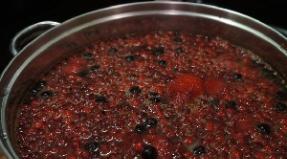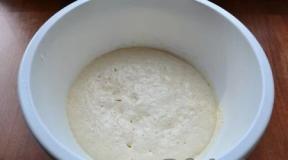Oysters and mussels. Better than Viagra! Mussels boiled in shells
Mussels in shells
What's inside the shell
As a child, reading about the old life abroad, I mentally lived all the plots together with the book heroes: I felt, grieved, rejoiced. And she ate. I ate their magical delicious book food. A particularly intriguing dish seemed to me to be oysters, which in modest Soviet illustrations resembled large plastic clips.
I knew that oysters are sea shells that must be eaten in a special way, opening the tight latch with a special cutlery tool (I wonder which one?), And swallowing their slippery carcasses almost raw. In my fantasies, oysters were something austere, expensive and aristocratic. Unlike mussels, which were more often mentioned in stories about a difficult and hungry life. From the novels, I realized that these edible shells differ in size (oysters are larger) and shades of taste - mussel meat is sweeter and more tender.
Plunging into the plot, I tried on the heroines' gorgeous dresses, their shoes, jewelry with might and main, soaked cambric handkerchiefs with a monogram with real French perfume, performed feats, fell in love, suffered, shuddered on bumps in the carriage, dashingly rode horses ... stumbling only over the rules of etiquette. I realized with horror that if they offered me oysters at dinner in decent society, it would be very embarrassing, because I don't know how to eat them correctly. For some reason, the question of who would treat a Soviet child with such a curiosity did not arise in my mind.
The fact that another miracle is born in the shells of mollusks - pearls, which were worn by many book beauties, only increased the intrigue.

What's inside an oyster shell
Of course, in films about life abroad, they sometimes showed how the heroes gracefully and deftly handle various edible shells, but I did not have time to consider all the details, and there was nothing to train on.
In the mid-nineties, exotic bourgeois delicacies first appeared in post-Soviet stores: frog legs, snails, oysters, mussels and all sorts of other animals. You could see their frozen carcasses, but how to properly eat mussels (and cook) remained a mystery.
Mussel taste
And when, many years later, in an overcrowded Greek psarotavern (fish restaurant, from the gr. "Psarya" - fish) I was offered a menu in some non-Greek and not at all Russian language, I had to choose dishes whose names resembled at least something familiar and affordable. I ordered it. What is completely incomprehensible, but from the section of main courses. Five minutes later, a dish was brought, where small oval carcasses of some orange-sandy sea animal, sprinkled with lemon, were floating in warm olive oil. I tried it. There were no words. There was only a sweet-salty trickle of taste that slowly faded in the mouth. These juicy lumps “for one bite” turned out to be mussels. And no shells and frightening devices for opening them were observed around. This is how my childhood dreams came true by chance. It was so delicious!

When you have eaten a mussel, this pearlescent shell remains from it!
Where do mussels and oysters come from?
In general, the love for oysters and mussels has a long history. Of course, no one knows exactly when people first guessed to taste the contents of the sink. Gathering shellfish is as ancient as mushroom hunting (by the way, mussels fried in butter taste like porcini mushrooms). Archaeological excavations confirm that already in the Stone Age, oysters and mussels were included in the diet of the peoples who inhabited the sea coasts. And the chroniclers of Ancient Rome mentioned that oysters were becoming less and less and therefore people began to artificially breed and grow them. This is how someone bred chickens and geese, and someone - oysters.
Our distant ancestors loved edible shells because they were tasty, nutritious and easy prey. They could be devoured both raw and fried, made an excellent broth from them, tender shellfish meat harmoniously combined with vegetables, lemon juice and sea salt - that is, everything that was at hand.
Collecting shellfish does not require serious efforts and tools. They can be found on the underwater parts of coastal rocks, port facilities and on other solid foundations to which the larvae attach at the beginning of their life. Then they grow, gradually filling the entire surface of the substrate. The hunters need to find these clusters of shells and carefully separate them from the base.
It is best to collect mussels and oysters away from civilization, where they grow larger, and the water, which is constantly passed through by the molluscs, is cleaner. Nature has endowed mussels and oysters with this feature, not only for the purification of sea waters. The shell, firmly adhered to the substrate, lives its life in immobility, and, therefore, feeds only on what the sea waves bring it. By absorbing water, which is involved in the process of respiration, mollusks also feed on microorganisms that inhabit the sea.
They just end up on the kitchen table - with salty water in the sink. If you bought frozen mussels or oysters, then in the process of defrosting the shellfish, a wonderful scent of the sea will hover in your house. For those who dream of relaxing on the beach, this smell in simple Russian cuisine is like a vitamin, invigorating cocktail that awakens joyful memories of the sea air, sun and waves. The smell of thawed mussels and oysters will drive away any melancholy and gloom.
Of course, you are unlikely to be able to find oysters in the wild; they are supplied to shops and restaurants from special oyster farms. But mussels can still be obtained on their own.
Processing of mussels and oysters
And if these wonderful shells turned out to be in your kitchen, the first thing to do is rinse them thoroughly, removing the residues of the substrate, sand, silt and algae, remove the intestines (you will see something black under the skin).
Shelf life of fresh mussels and oysters
You cannot store raw mussels and oysters for a long time; they need to be dealt with even faster than fish. We washed and cleaned the mollusks, you can leave the shells ajar (whole), you can break off and discard 1 flap, or even remove the mussel from the shell, depending on what you will continue to cook and how to serve it.
A dish of mussels (cooked) can be stored in the refrigerator, but I would not drag it out for more than 12 hours, you never know. And freshly cooked mussels and oysters are tastier.
So, we need to decide whether we eat raw clams, cook a dish of mussels or oysters, or freeze them until better times
Can you eat mussels and oysters raw?
Do mussels and oysters squeak when eaten
There is a funny misconception associated with eating raw oysters and mussels. Some believe that when you drink a fresh mollusk from a shell, it, realizing the inevitability of death, squeaks desperately. Scary story, isn't it ?!
In fact, mollusks do not have vocal cords (have you ever heard of mollusks talking, singing, especially under water, where do they live?) pressure, air whistles into its cavity.
It is believed that after thoroughly washing the shells and removing the intestines (this is if you yourself caught the shellfish, the purchased mussels and oysters are usually processed), you need to soak them in clean, cool water for 2-3 days or for several hours.
After they can be eaten (drunk) raw, after opening the shell.
How to eat raw mussels and oysters
How to open a raw oyster or mussel
The shell of an oyster or mussel should be turned with the pointed tip towards you and a small and not very wide knife (so that the blade does not spring and break) or a special oyster fork should be inserted where the upper and lower flaps converge.
Fold back the mussel flaps. To do this, you will have to make a little effort - the muscle of the mollusk, located in the middle of the shell, will tend to slam the shutters. After overcoming the resistance, open the shell, drain the water, cut the muscle (with a knife or the cutting part of the oyster fork), remove this muscle, thus separating the tasty shellfish from the shell.
What to eat with raw mussels and oysters
Sprinkle lemon on oyster or mussel meat, sprinkle with coarse salt or sea salt (since you find yourself where they eat fresh shellfish, you will probably find it), you can pepper a little. Some gourmets prefer hot spices - chili sauce, horseradish and a variety of sauces.
How to eat raw mussels and oysters from the shell
And after you have seasoned the mussel or oyster meat - delicately and silently drink the contents of the shell from the sash, bringing it to your lips from the deeper and more rounded side of the shell, so that it is both comfortable and aesthetically pleasing.
Why do we “drink” if the mollusk is meat, and the water from the shell, in which it splashed on the way from the sea to the table, has already been drained? The fact is that after opening and draining, the mollusk gives up the previously absorbed water, and the juice reappears in the shell, which is very appreciated by gourmets.
How to serve fresh mussels and oysters
"The oysters in ice smelled fresh and pungently of the sea on a saucer ..." - wrote Anna Akhmatova, noting one more nuance - it is customary to lay raw mollusks on a dish sprinkled with finely crumbled ice. Ice-chilled raw oysters and mussels get a clearer, more distinct flavor and stay fresh longer.
Shellfish are often served with cookie cracker, which is convenient to scoop up the sauce and eat shell meat.
It is customary to serve with fresh mussels and oysters and White wine... Still very appropriate will be bowls with water and a slice of lemon(to discourage the smell of my food) and wet towels or heated wet wipes for hands.
Of course, the chef can make your task easier and serve the clams open, but it's boring! How can you miss such fun with mussels and oysters ?!
Signs of freshness of mussels and oysters
In addition, it is believed that opening clam shells with your own hands will save you from stale and stale food. If the shells open the flaps themselves, then they are already lethargic and fall asleep - the shelf life has expired, but they themselves have opened or the cook helped them, you will definitely not know. Also, take a closer look, the carcass should have a healthy, appetizing appearance, dried, twisted specimens - inedible!
It is believed that the tastiest will be oysters harvested in the month of the year, which contains the letter "p". This is due to the fact that from May to August in mollusks, the breeding period and the strength of their body are directed to the continuation of the genus, they lose weight and taste.
Isn't it scary to eat raw oysters and mussels?
The first sensation of an oyster swallowed and sliding further can be ambiguous, unusual, strange, so it is better to give yourself time to get used to and swallow it at first without chewing. The feeling of buzz and delight, the need to repeat these special feelings will come a little later and will be remembered by you forever.
Or, who knows, you may never again dare to try this delicacy, even hot. I assure you - raw and cooked shellfish are completely different - touch your tongue, chew them, feel the tingling of the taste buds and the structure of the pieces ... and you will understand what I mean. Probably, the most vivid sensation from a raw product is born mainly at the moment it slides down the esophagus, but from a cooked one - in the mouth, when you chew and feel the taste in different parts of the tongue. And if, nevertheless, raw oyster and delicacy are incompatible concepts for you, try fried, baked, boiled or stew of clams.
How to find mussels and oysters in the store
So, you've decided to cook a dish of mussels or oysters. If you are now far away from shellfish habitats, look for these seafood delicacies in the frozen food section of your supermarket. Mussels and oysters can be in shells, shell halves, or just carcasses. Sometimes the catchy inscription on the packaging is in a foreign language, and the Russian translation is so small that you don't immediately understand.
So, if you want mussels, look for the inscriptions: mussel(in English), de mossel ( in German), moule(in French), mitilo, cozza(in Italian), almeja(in Spanish), μύδια (in Greek).
If these are oysters, then their names in foreign languages are as follows: oyster(English), Auster(German); huître(French), ostrica(Italian), ostra(Spanish), το στρείδι (Greek).
When defrosting the clams, be sure to smell them. I think they can be bought because of the bright scent of the sea and freshness alone! The smell is intoxicating, uplifting and beckons to the distant southern lands! It's just a miracle!

Delicious mussels (boiled) with garlic sauce
How to open mussel and oyster shells when cooking
If you get shellfish, the first step is to open them. The shells need to be heated, for this they are suitable: a cast-iron frying pan, a saucepan with thick walls (you can add water to the dishes, the flaps will open in water, and you will have an excellent broth, which must be filtered before further use. surface), a baking sheet, and in nature a sheet of iron or an empty tin can also come off.
Mussels should not be exposed to prolonged heat treatment, otherwise they will be tasteless and dryish. The same principles apply here as when cooking squid.
Or - you can pour boiling water over the shells. When heated, the muscle of the mollusk stops closing the shell valves, and they easily swing open. This muscle is then trimmed to ease the taster's lot. In general, you can eat right after disclosure. And you can continue the cooking process.
What to cook with mussels or oysters

Photo of a delicious dish made from oysters by Alexander Ostapenko
There are many other delicious and interesting shellfish dishes out there. You can use mussels and oysters in dishes that you could add fish, shrimp, or squid to. Remember that mussels and oysters cannot be cooked, fried or stewed for a long time, they are cooked quickly, in one go.
Excellent soups are made from oysters and mussels, pilaf is prepared, clams are stewed with vegetables, under various sauces, with spices, barbecue is fried, salads and paella are prepared. Recently I fried potatoes and added boiled mussel meat to them at the end - very tasty!
Mother-of-pearl shells with pieces of meat, laid out on colorful vegetable dishes or sticking out of rice porridge, look very funny. At first glance, it seems that it is inedible, because on top of the wonderful products are some kind of bone boats! And then you think - and how did we gobble everything up so quickly ?!
Unlike oysters, mussels are eaten all year round. Especially in our country, where this wonderful seafood comes mainly frozen. The main thing for us is to learn how to choose high-quality mussels and be able to cook them. And you can make anything from shellfish: light salads, delicious pasta, soufflé, soup or risotto. Why is he so appreciated?
Appreciated for ...
Mussels are good for both ladies and their life partners. The former appreciate them for their extremely low calorie content: if a piece of pork or lamb weighing 100 g on average pulls 250-300 kcal, shellfish meat gives only 50 kcal (even shrimp has a higher calorie content and is about 80 kcal). Therefore, you can safely enjoy the good taste and delicate texture of the mussel and not be afraid to spoil your figure. This seafood is also incredibly healthy for this and is a real aphrodisiac.
It's all about the unique shellfish meat, which contains almost no carbohydrates, but has a high concentration of high-quality protein, vitamins B and E (the latter is called by professionals "bearing offspring"), polyunsaturated fatty acids omega-3, iodine, calcium and magnesium. At the same time, mussels have little cholesterol and a lot of phospholipids, which have a beneficial effect on liver function. In general, this seafood is incredibly healthy, so you should periodically include it in your menu. True, do not forget that poisoning by sea reptiles is one of the most terrible, so choose mussels very carefully for your culinary masterpieces.
Shellfish farm
The mussel, beloved by many gourmets, is found in almost all of the world's oceans, but mass industrial production is carried out only in some parts of the world. Let's say that seafood "comes" to our country from China, New Zealand (large green "kiwis" are just from there), there are some Spanish and French products, and almost 50% of shellfish comes from Chilean Patagonia - the southernmost and least populated region of Chile, washed by the cold waters of the Pacific Ocean. The cultivation of mussels on farms is as follows: the fry are slightly reared and sent to the ocean, where they hang on ropes like giant bunches of grapes and build up their mass within 8-15 months. At the same time, seafood is not fed with anything - it grows in natural conditions, constantly filtering the water and feeding on valuable plankton. Then the grown mussels are taken out of the ocean and subjected to two procedures: canned or scalded with hot steam and frozen.
Rather dead than alive
If you are lucky enough to buy fresh mussels, make sure that all shells are closed. If they are ajar, then the mollusk is more likely dead than alive. You can even tap the shell with your finger - if it reacts and shrinks, then everything is okay, if not - this seafood is dangerous for the stomach. Another important indicator of the freshness of the sea reptile is the absence of a specific smell. Professionals say that good mussels should smell only of the sea. However, in our country, mussels are sold mainly in a boiled-frozen state, so you can only understand whether they are fresh or not after defrosting. better to refuse.
In the sink or not?
Unlike shrimp, which can vary in size, mussels do not have a wide variety of shapes. There are large delicacies (35/40), bearing the fruit name "kiwi", and there are medium-length clams, of which there are 40 to 60 pieces per kilogram - they are the most popular. You can buy seafood in a whole shell (it is steamed and vacuum packed), in a half shell, or a clean fillet. In any case, mussels should not be covered with a very thick layer of ice, and even more so they cannot have snow and yellow deposits - this indicates that the product was thawed and re-frozen. The clam meat should be light, voluminous, firm and have an excellent presentable appearance (black and flabby fillets indicate the old age of seafood). If you buy canned food or preserves, before buying, be sure to study brine - the brine in which mussels swim. It must be absolutely transparent, it cannot contain blood clots, mold and other foreign inclusions. Do not forget to also check the integrity of the packaging so that the oil does not leak out of the plastic jar and the vacuum bag is not torn. The label on the jar must be glued evenly and carefully, and all information on it must be stated clearly and understandably. If it is impossible to read the composition of the product, the letters blur and the piece of paper is kept crooked, then, most likely, such preserves were made in an underground workshop (they are usually prepared from thawed mussels).
Five secrets of making mussels
1. The best companion for mussels is white wine. They can be washed down with dishes or used to prepare "mussel" treats.
2. The best way to cook mussels is to use sea salt. The main thing is to remember that seafood already contains a certain amount of salt, so do not oversalt your dish.
3. Do not be afraid to combine lemon juice with any seafood, including mussels.
4. The best sauce for mussels is extremely easy to prepare. You need to mix olive oil, lemon juice, garlic and herbs.
5. Mussels are combined with absolutely all products - vegetables, dough, meat, chicken, fish and other seafood. However, true gourmets believe that it is best to cook shellfish in such a way that other ingredients do not interfere with their taste.

Seafood at all times was considered a delicacy that was served to the table of royal persons, but it could also easily become a meal of a humble fisherman. The benefits of seafood can hardly be overestimated, because they contain substances valuable for the body, vitamins, microelements. A favorite delicacy of gourmets has become sea inhabitants, which are often confused with each other - mussels and oysters. What is the difference between them? Even not every frequenter of an elite restaurant will answer this question on the fly.
Are mussels and oysters the same thing?
The differences between mussels and oysters are numerous, but upon a cursory examination, only external differences are striking. So let's talk about these molluscs in more detail.
If we turn to the science of malacology, then interesting facts will become clear. Oysters and mussels are bivalve molluscs found in the seas. But they belong to different orders: the first to the Ostreoida order, and the second to Mytiloida. To an ordinary person, this information does not mean anything, so let's determine the difference between mollusks, referring to their appearance. After all, this is what most people do.
It is more convenient to conduct a comparative analysis in the table.
| Specifications | Mollusc species | |
| Mussel | Oyster | |
| The size | Small | Large clam |
| Shell shape | More often drop-shaped, less often - round. Slightly concave to the touch | The shell is uneven with ragged edges. It is flat in shape, but there are also types with concave valves. |
| Sink cover | Smooth with slight waves | Rough with protrusions and depressions |
| Flap color | The colors have many shades. The most common color is brown interspersed with gold. Mussels of black color are often found | Light shades |
Even after such a cursory analysis, it becomes clear that the mollusks of interest to us are very different from each other.
The main difference between oysters and mussels
The scientific literature describes in detail how mussels differ from oysters. We will not go into specific terms. Instead, let's talk a little about each of the mollusks. According to this information, the reader himself:
- make the necessary conclusions;
- will remember the main differences;
- will choose one of the products.
Mussels
In malacology, the mussel is considered a traveler. She has the ability to move from stone to stone thanks to a special organ - the byssus. It is something that resembles a thread. Byssus is characterized by a number of features:
- thin;
- lasting;
- mobile.
The mussel releases a thread that securely attaches the clam to the stone. The byssus is long enough to stay away from the insertion site. The mollusk seems to sway on the leg. Mussels live in large colonies. At the same time, a clear order of arrangement is observed - in rows.

Oysters
These mollusks lead a completely different way of life than their "companions". They cannot move, therefore they "sit" on stones once during their entire existence. It happens as follows:
- oysters are pressed against the stone surface of one of the valves;
- the mollusc glands secrete a secret that acts as a mortar;
- after 10-20 seconds the secret turns to stone, fixing the sink securely.
Even during strong sea waves, this natural "cement" is not destroyed.
The peculiarities of the way of life of mollusks affected the organization of their colonies. They resemble piles of stones, as oysters are chaotically attached to each other. A full-fledged colony is often referred to as a "bunch". This shape makes it much easier to catch the mollusc.
Photo of oysters and mussels: differences
When trying to differentiate between mussels and oysters, photos are very helpful. We have placed two photos below, looking at which, the reader can easily figure out how different mollusks really are.
If you happen to dive with scuba diving, then you probably observed colonies of oysters or mussels under the water column. After this spectacle, you will never again confuse some mollusks with others.
In the ready-to-use form, they also differ markedly. This is expressed:
- in the manner of serving clams to the table;
- ways to use them.
Therefore, at a table in a restaurant, you are unlikely to find yourself in an embarrassing situation, calling an oyster a mussel, or vice versa.
Which is tastier - mussels or oysters?
This question can be safely attributed to rhetorical. Each person has his own taste preferences. Gourmets from all over the world appreciate the taste of both shellfish. They rely primarily on their preferences. We will try to be impartial, figuring out which dish is tastier - oysters or mussels.

The nutritional value of the product is the nuance that interests chefs and housewives. The dish served to guests or household members should give a feeling of satiety for a long time. What do culinary experts say about the calorie content of shellfish? They consider the nutritional value to be identical. Therefore, they cannot give the palm to someone alone. If you are hungry, but want to order something exotic at a restaurant, then the feeling of satiety from a portion of mussels and oysters will be the same.
The subtleties of the taste differences between shellfish are difficult to describe. There are 3 categories of gourmets:
- preferring oysters;
- picking mussels;
- who regularly eat both types of shellfish.
They say that after the first tasting, you will once and for all refer yourself to one of the listed groups. But keep in mind that mussels:
- are a strong allergen
- go to food only after heat treatment.

Oysters are eaten raw, so their shelf life is extremely limited. This clam:
- gentle;
- does not tolerate frost;
- used according to the rules.
It is delivered to restaurants and shops on ice. People suffering from gastrointestinal problems are advised to treat this mollusc with caution. Oysters, even in small quantities, can provoke an upset stomach.
A dream for many people is the opportunity to taste a real delicacy that is only talked about in the circles of the rich and famous. One of these incredibly popular gourmet products is oysters, which are served on the tables of the best houses and restaurants. Such an unusual product is appreciated for its sophistication, extraordinary taste and colossal benefits, which allows it to always be a welcome guest at banquets.
What oysters look like: description
Oysters are invertebrate bivalve molluscs most commonly found in warm (tropical) seas. Most often they can be found near the shores of the Japanese and Black Seas, in the Pacific and Indian Oceans, as well as in the Atlantic and Mediterranean.
They have an asymmetric shell, with an oval-wedge-shaped or irregularly-rounded shape. Externally, oysters may appear concave (deep) or flat. Their inner surface is covered with a mother-of-pearl layer, and inside the shell itself there is an edible mollusc. Many connoisseurs of real delicacies consider oysters with a one-sided convex shell to be the greatest delicacy of all seafood.

Most of all, mollusks love slightly salted sea water, which is why most of them live exclusively in the intertidal zone near the mouths of rivers.
It is believed that the taste of oyster meat, as well as their growth, depends on the degree of salinity of the water. Mollusks, which from the very first days of their life were found in seawater with a salinity mark of 20-30 ppm, are deservedly ideal, in terms of taste, and were collected there. If the salt level in the sea is higher (about 35 ppm), then the oysters will grow faster, but their meat will be much tougher than shellfish from slightly salted sea water.
Oysters come in a variety of sizes. For example, European species are characterized by a shell length of 8-12 cm, some other species reach gigantic, as for mollusks, in size - 40-45 cm.
They start spawning in spring and finish only at the end of summer. Over the entire season, oysters lay up to 500 million eggs. Oysters can live both singly and in colonies (multilayer mollusk settlements).
The largest producer of bivalve molluscs is the United States. The second largest producer is Japan, followed by South Korea. France did not make it into the top three countries, it only ranks fourth. However, it is the French oysters that are the most popular all over the world.
Bivalve molluscs have up to 50 varieties. They are all classified by weight, habitat and size characteristics. In accordance with the last parameter, oysters are divided by numbers.
In flat bivalves molluscs, the size is indicated by zeros, the largest size is 0000.
Concave oysters divided by numbers. From No. 0 to No. 5, the molluscs are considered the smallest, and No. 00 is the largest.
In European countries, the most popular are oysters No. 3, weighing from 80 to 100 grams.

By origin there are 2 types of oysters: full sea molluscs (living from birth only in the sea) and refined (living in artificially desalinated water).
The latter, in turn, have several more subspecies, depending on the density coefficient of the mollusk. The density coefficient of an oyster is understood as the ratio of the weight of the meat of 20 molluscs of the same size to the weight of 20 mollusc shells, multiplied by 100.
According to the density coefficient there are such types of oysters as:
- special,
- pus-an-claire,
- special de clair,
- fin de clair.
In addition to food (Pacific, Belon, Stone Sydney, Adriatic, Black Sea, Mediterranean, etc.), there are pearl oysters. They are not suitable for human consumption, only natural pearls are obtained from them.

Oysters are a special type of seafood that contains many vitamins, minerals, micro and macro elements.
The composition of oyster meat includes: protein, iron, copper, iodine, phosphorus, calcium, nicotinic acid, selenium, glycogen, vitamins PP, A B, D.
Such a unique chemical composition has a positive effect on the functioning of many organs and systems of the human body.

Thanks to the successful combination of nutrients, molluscs are capable of:
- improve vision;
- strengthen bone tissue;
- tonic effect on the nervous system;
- normalize the functioning of the liver and kidneys;
- prevent the appearance and growth of cancer cells.
Aphrodisiac
Oysters also contain two amino acids that stimulate the production of sex hormones in the human body.
Thanks to the zinc in seafood, oysters affect the synthesis of testosterone in men and women. Therefore, molluscs can deservedly be considered a natural aphrodisiac.

Diet product
In general, oysters are a low-calorie dietary product. The protein they contain is easily digestible.
And by themselves they are not greasy. Many people perceive the shine of shellfish meat as fat, but the shine is caused by a large amount of glucose in the product, but not by fat.
Table of beneficial elements in oyster meat
For 100 gr. oysters account for approximately 78 kcal. In order to visually see the calories in action, we have compiled a table of useful elements contained in shellfish meat, and we present the number of calories for each of them for review.

| Useful material | Calculation for 100 gr. product |
| Squirrels | 9, 45 gr. |
| Water | 82.06 g |
| Carbohydrates | 4.95 gr. |
| Fats | 2.3 gr. |
| Ash | 1.23 gr. |
| Vitamins | |
| Niacin (vitamin B3 or PP) | 2.01 mg. |
| Vitamin A (retinol) | 81 mcg. |
| Vitamin B1 (thiamin) | 0.067 mg. |
| Vitamin B2 (riboflavin) | 0.233 mg. |
| Vitamin B5 (pantothenic acid) | 0.5 mg. |
| Vitamin B6 (pyridoxine) | 0.05 mg. |
| Folic acid (vitamin B9) | 10 mcg. |
| Vitamin B12 (cyanocobalamin) | 16 mcg. |
| Vitamin C (ascorbic acid) | 8 mg. |
| Trace elements | |
| Iron | 5.11 mg. |
| Zinc | 16.62 mg. |
| Manganese | 643 mcg. |
| Copper | 1.576 mg. |
| Selenium | 77.0 mcg. |
| Macronutrients | |
| Potassium | 168 mg. |
| Magnesium | 22 mg. |
| Calcium | 8 mg. |
| Phosphorus | 162 mg. |
| Sodium | 106 mg. |
Contraindications and harm to oysters
Why bivalve molluscs are useful - we have already found out. But how they can harm human health - you need to figure it out.
It is important to remember that you only need to eat live oysters. It is categorically impossible to eat dead shellfish. You can understand that an oyster is alive by its reaction. If, when the shell is opened, the body of the mollusk trembles, it means that it is alive.

Oyster poisoning
Given the fact that the delicacy is most often eaten raw, it makes no sense to deny the risk of oyster poisoning. It can be caused by infection of shellfish with any food infection or their non-viability.
Oyster poisoning is a fairly common phenomenon. To avoid it, you need to take care of the freshness of the product in advance and know who and where will supply it.
Contraindications
Despite all the benefits of shellfish, they also have a number of contraindications.
- People with diseases of the gastrointestinal tract and spleen should not use oysters.
- Pregnant women and women during lactation should also refuse to eat shellfish.
- People with gout are not allowed to eat shellfish raw or otherwise. Since the protein in oysters is able to convert into uric acid, which forms crystals that settle on the joints. This can be unpleasant painful sensations.
Oysters and mussels: differences
Many people do not see a significant difference between these two representatives of the marine world. However, it still exists. Even considering the kinship of seafood (they both come from the bivalve family), oysters and mussels are different.
Appearance
The first difference is their appearance... Oysters are much larger and have a flat or concave shell.
Mussels are smaller in size and have a drop-shaped, round or concave shell shape.

The difference in cooking
Oysters can be eaten raw, but mussels without heat treatment are not advisable. They accumulate in themselves a lot of harmful substances, which will not have the best effect on the health of their consumers.

Mussels can also harm allergy sufferers, therefore, people prone to allergic reactions should not eat mussels.
Price
Well, another difference between mussels and oysters is the difference in price - mussels are much cheaper.
In European cuisine, oysters are considered a special aristocratic delicacy. The most popular consumption is considered to be raw shellfish, when the fresh sea aroma is especially noticeable in the taste. In order not to spoil the seafood, it is necessary to open the oyster shell carefully and correctly.
How to open an oyster
To do this, you need to use a special oyster knife, the blade of which must be inserted between the flaps in the place where the muscles that lock the flaps are attached.

When the shell is open, the body of the mollusk must be sprinkled with lemon juice, after which the oyster can be drunk from the shell. To preserve the special taste and aroma of the shellfish, oysters are served in shells on ice with a slice of black bread.
What to file with
For a more piquant product, it is customary to serve various sauces, additives and wine with oysters.
The fresh aroma of seafood goes well with red caviar, balsamic and raspberry sauce, black pepper, Tabasco sauce, avocado puree, etc. Also served with oysters is dry white wine, Brut champagne and even light beer.

Using oysters as an element in dishes
Sometimes, semi-finished products are prepared from fresh shellfish, preserving them. Canned oysters are used in a variety of dishes such as toast, cocktails, exotic salads, soups, etc.
You can enjoy the beneficial properties of oysters not only when the shellfish are raw. They are no less useful and tasty as part of other dishes.

In the cuisine of many countries, there are many recipes according to which you can cook fried, boiled, baked, batter and deep-fried dishes from oysters. If you cook them not from fresh, but from frozen shellfish, then the seafood remaining after cooking cannot be frozen a second time.
Eating oysters is the correct health improvement of your body. The benefits of bivalve molluscs were created by nature itself, which is why oysters are so prized among seafood lovers and supporters of healthy eating.
Even with the rare use of shellfish in food, the body will be significantly enriched with useful substances. Do not forget just to carefully choose and use the edible shellfish correctly, because aristocratic seafood loves an exquisite approach.
The waters of the oceans are inhabited by a wide variety of creatures. Some of them, mussels, have long been recognized as tasty and healthy food, despite their unsightly appearance. Initially, they were used as food by poor fishermen who could not afford beef and pork. Later, the nobility tasted the unique delicate taste of these, and mussels appeared on rich tables, complementing an extensive diet. Many people neglect these seafood due to their specific look and texture. In this article, we will look at the beneficial properties of these bivalves, their significant differences from oyster molluscs and their effect on the human body.
Calorie content and nutritional value
It is an ideal product for those who are in good physical shape. Every 100 grams of these shellfish contains total 77 kcal.
 The content in them is huge - 12% of the total mass of the mollusk. in 100 g, only 2 g, and almost all of this volume is occupied by polyunsaturated, which are only beneficial for the human body.
The content in them is huge - 12% of the total mass of the mollusk. in 100 g, only 2 g, and almost all of this volume is occupied by polyunsaturated, which are only beneficial for the human body.
Important! These shellfish are strong allergens, so only those people who do not have a tendency to food allergies can eat them.
Vitamin and mineral composition
The benefits of seafood
There are controversies surrounding this food product. Some people believe that high-protein mussel meat is becoming irreplaceable. a source of proteins and amino acids in the human diet. Others avoid this product, since mussels, when foraging, pass the surrounding water through their bodies. This leads to the accumulation of toxins and heavy metals from the environment in their pulp. 
For men
The work of the nervous and muscular systems depends on the intake of vitamins and minerals in the body, in particular. Mussels are a reliable source of these vitamins. They strengthen muscle connections, establish neural connections, therefore, the male body is recovering... Zinc is responsible for hormonal balance. It increases the amount of the male hormone testosterone in the blood. A man who regularly consumes these shellfish improves spermatogenesis.
Did you know? For the first time, oysters were included in the official classification of marine organisms in 1758. In 1822, they were assigned a separate detachment among bivalve molluscs. It is noteworthy that they were known to mankind for a long time. Twelve thousand years ago, American Indians consumed them, deliberately growing them on homemade river and lake farms.
Organic folic acid is responsible for metabolic processes in the cells of the tissues of the human body. It normalizes them - the genetic information is more reliably protected, the likelihood of healthy offspring increases. Iodine, which is found in excess in mussels, is responsible for the proper functioning of the thyroid gland. The thyroid gland protects the male body from pathogenic viruses and microorganisms, inhibiting their activity as the blood is filtered.  These molluscs have the most significant effect on male sexual function. They improve blood circulation in the reproductive system, sperm quality and increase libido. The walls of the vessels are strengthened, the blood supply to the cavernous bodies of the genital organ is more intense, and the erection is enhanced. The prostate gland or prostate, partly responsible for the production of sperm, is restored - this is an excellent prevention of prostatitis in adulthood and old age.
These molluscs have the most significant effect on male sexual function. They improve blood circulation in the reproductive system, sperm quality and increase libido. The walls of the vessels are strengthened, the blood supply to the cavernous bodies of the genital organ is more intense, and the erection is enhanced. The prostate gland or prostate, partly responsible for the production of sperm, is restored - this is an excellent prevention of prostatitis in adulthood and old age.
For women
The effect of mussels on the female body is similar to their effect on the male body. Iodine, which is part of the pulp of mussels, strengthens its own, reduces the level of harmful by increasing the level of useful. The low calorie content of these shellfish, as well as their ability to speed up metabolism, help to quickly get rid of extra pounds on a specially designed diet.
The vitamin composition of these seafood contributes to beauty, skin health and strength. Vitamins and improve complexion, get rid of mimic, strengthen tooth enamel, etc.  The mucous tissues of the female reproductive system regenerate faster, and the uterus will be ready for embryo implantation if you eat mussels preserved in oil every two days. In addition, increased sex drive increases the chances of a good conception.
The mucous tissues of the female reproductive system regenerate faster, and the uterus will be ready for embryo implantation if you eat mussels preserved in oil every two days. In addition, increased sex drive increases the chances of a good conception.
Important! The protein contained in the pulp of these molluscs is decomposed during fermentation into acids, which negatively affect the elasticity of the cartilage tissue. This food is contraindicated for people suffering from arthritis.
How to eat mussels
From an unfamiliar exotic delicacy, this food has turned into a familiar dish, but you need to know how to handle it. Mussels are not the most convenient food, so practice before eating them in public. The ready-made pulp is already served in restaurants cleaned and processed, you can take it off the skewers and eat it right away. Order from drinks, as an option - white wine.
If you got unrefined shellfish, then tongs and a fork must be served with them. The tongs should be held in the left hand and the fork in the right. Squeeze the clam with them and remove the pulp with a fork. You can rinse it in a special bowl of acidified water and only then eat. Soup with shells is eaten in much the same way. First, catch, peel and eat all the clams, and then spoon out the broth with a spoon.  Raw meat can be eaten without a fork. Take open clams in your hand and suck them out of the shell with a sucking motion. In order not to chomp while doing this, practice a couple of times on homemade clams. Pay attention to the liquid that accumulates in the pulp and, when opening the shell, can spray you, the tablecloth and those sitting next to you. This food should not be hastily handled.
Raw meat can be eaten without a fork. Take open clams in your hand and suck them out of the shell with a sucking motion. In order not to chomp while doing this, practice a couple of times on homemade clams. Pay attention to the liquid that accumulates in the pulp and, when opening the shell, can spray you, the tablecloth and those sitting next to you. This food should not be hastily handled.
Is it possible for pregnant and lactating mothers
This product has different effects on pregnant and lactating women. It is worth noting that infants are especially prone to allergic reactions, therefore, nursing mothers with this product need be careful... Until the child is six months old and his immunity is not strong enough, do not eat these seafood.
After six months, introduce mussels gradually. Eat a few shellfish and watch your baby's reactions throughout the day. If he develops an allergic rash or redness, skip the shellfish for another two to three months. If the reaction is negative, you can increase the portion.
Pregnant women these seafood shown for use... As a source of complete, easily digestible protein and essential amino acids, they serve as a good addition to. Mussels for pregnant women should be of exceptionally high quality. Always check them for freshness and ask the seller for a certificate of sanitary inspection.  These mollusks filter water, allowing both useful and toxic substances to pass through themselves, and some of them accumulate in their pulp. Unscrupulous producers can feed mussels with food waste instead of quality feed. Such products will not bring any benefit.
These mollusks filter water, allowing both useful and toxic substances to pass through themselves, and some of them accumulate in their pulp. Unscrupulous producers can feed mussels with food waste instead of quality feed. Such products will not bring any benefit.
In any case, pregnant and lactating women are prohibited from eating raw mussels. Be sure to boil them or steam them for at least twenty minutes. So you exclude the possibility of infection with infectious diseases and worms.
Did you know? In a day, this sea creature is able to pass through itself up to eighty liters of water. Given its tiny body size, this capacity is comparable to the powerful dams of a hydroelectric power station.
What is the difference between mussels and oysters
First, they are distinguished from each other. appearance... In mussels, the shell is small, black, smooth, occasionally overgrown with other mollusks, and they grow in rosettes, attaching themselves in rows. Oysters have a slightly deformed shell, similar to limestone deposits, and are attached to stones in layers - smaller ones on larger ones. Mussels can move, which distinguishes them favorably from oysters that settle in one place, even if it is polluted, for life. Mussels have a muscular leg that propels their shell and body over rocks.  Their nutritional value practically does not differ, but mollusks with a black shell contain more, and limestone ones. Both seafood and others are consumed raw, but mussels are more dangerous in this regard, since they feed on everything, including toxic waste. They should not be consumed by allergy sufferers, and oyster shellfish provoke digestive problems in people suffering from peptic ulcers. The price is also different - oysters are more valuable.
Their nutritional value practically does not differ, but mollusks with a black shell contain more, and limestone ones. Both seafood and others are consumed raw, but mussels are more dangerous in this regard, since they feed on everything, including toxic waste. They should not be consumed by allergy sufferers, and oyster shellfish provoke digestive problems in people suffering from peptic ulcers. The price is also different - oysters are more valuable.
Contraindications and harm
The negative effect of these seafood on the body is due to their specific composition. They are not recommended for people with diseases of the joints and vertebrae, since the protein they contain is processed in the body into uric acid. The acid crystallizes after synthesis and as a solid phase is deposited in the cartilaginous tissues, provoking pain.  Allergy is another reaction to the protein component of oyster pulp. It is not only straight, but also cross-linked, which means that mussels can harm those who are allergic to wheat protein.
Allergy is another reaction to the protein component of oyster pulp. It is not only straight, but also cross-linked, which means that mussels can harm those who are allergic to wheat protein.
These molluscs filter the water in which they live and accumulate various kinds of toxins. If grown in industrial areas with polluted waters, their meat will contain a high percentage of saxitoxin, which has a paralyzing effect on the nervous system. Therefore, it is so important to buy seafood from a trusted supplier, avoiding Korean and Chinese products.
Did you know? Japan has given this seafood significant symbolism. In Japanese culture, the reliably connected shells of the shell signify a strong union of lovers who create a young family. No wedding celebration in the Land of the Rising Sun is complete without the traditional mussel soup.
The benefits of these seafood can hardly be overestimated. Their unique vitamin and mineral composition is balanced and provides a person with everything he needs. The protein component is easily absorbed, which is beneficial for people with impaired digestion and those who are recovering from a long illness. Mussels have a positive effect on the sexual function of both men and women, increasing the likelihood of a desired conception and a successful pregnancy. Careful selection of a quality product and proper heat treatment will ensure that these shellfish taste good and make them frequent guests on your table.



















